RJ25 connectors, typically used for telephone systems, have 6 positions with 2 to 5 contacts, while RJ45 connectors, standard for Ethernet networking, feature 8 positions with all 8 contacts wired for high-speed data transmission. Understanding the differences between RJ25 and RJ45 can help you choose the right connector for your communication needs; explore the rest of this article to learn more.
Comparison Table
| Feature | RJ25 | RJ45 |
|---|---|---|
| Connector Type | 6P6C (6 positions, 6 contacts) | 8P8C (8 positions, 8 contacts) |
| Common Use | Multi-line telephone systems | Ethernet networking, broadband internet |
| Cable Type | Telephone cable, 4-pair | Twisted pair Ethernet cable (Cat5e, Cat6, Cat7) |
| Pin Configuration | 6 pins supporting up to 3 phone lines | 8 pins supporting data transmission and PoE |
| Supported Speeds | Analog voice | Up to 10 Gbps (Gigabit Ethernet) |
| Typical Applications | Telephone handsets, PBX systems | Local Area Networks (LAN), internet connections |
| Backward Compatibility | Limited, specific to telephony | Widely compatible with networking devices |
Introduction to RJ25 and RJ45
RJ25 and RJ45 are both types of modular connectors used in telecommunications and networking, but they serve different purposes and have distinct designs. RJ25 features a 6-position, 6-contact configuration primarily for telephone systems, supporting up to three telephone lines, while RJ45 uses an 8-position, 8-contact setup widely adopted for Ethernet networking and data transmission. Understanding the specific use of RJ25 versus RJ45 ensures your cabling infrastructure meets communication requirements efficiently.
Physical Differences: RJ25 vs RJ45
RJ25 connectors feature six positions and six contacts (6P6C), commonly used for telephone applications, while RJ45 connectors have eight positions and eight contacts (8P8C), primarily utilized for Ethernet networking. The RJ25's smaller size and fewer pins make it unsuitable for high-speed data transmission compared to the larger RJ45, which supports higher bandwidth and faster network speeds. Physically, the RJ45 is wider and thicker, designed to accommodate more wires, whereas the RJ25 is compact, tailored for multi-line telephone systems.
Pin Configuration Comparison
RJ25 connectors feature a 6-position, 6-contact (6P6C) configuration primarily used in telephone systems, while RJ45 connectors have an 8-position, 8-contact (8P8C) design commonly employed for Ethernet networking. The main difference in pin configuration lies in the number of contacts, with RJ45 supporting more complex data transmission through additional pins. Understanding your device's requirements can help determine whether the RJ25's simpler pin layout or the RJ45's more extensive configuration best suits your connectivity needs.
Supported Cable Types
RJ25 connectors support 4-conductor cables, commonly used for telephone and audio applications with flat or round modular cables. RJ45 connectors support 8-conductor cables, primarily designed for Ethernet networking using twisted pair cables like Cat5e, Cat6, and Cat7. The difference in supported cable types directly affects their compatibility, bandwidth, and usage scenarios in communication systems.
Typical Use Cases for RJ25
RJ25 connectors are commonly used in telephone systems and point-of-sale (POS) devices, supporting multiple lines with a 6-position, 6-conductor configuration. Unlike RJ45 connectors, which are standard for Ethernet networking, RJ25 is ideal for your multi-line telephone setups and certain audio equipment. Their ability to handle more conductors than RJ11 makes RJ25 suitable for specialized communication devices requiring up to six wires.
Common Applications of RJ45
RJ45 connectors are predominantly used in Ethernet networking for both residential and commercial environments, facilitating data transmission in local area networks (LANs). They are essential in connecting computers, routers, switches, and other network devices for internet access and communication. Common applications include Gigabit Ethernet, Power over Ethernet (PoE), and high-speed network cabling systems.
Data Transmission Capabilities
RJ45 connectors support higher data transmission speeds up to 10 Gbps over Ethernet cables, making them suitable for modern high-speed networks. RJ25 connectors typically handle lower data rates and are often used for specialized telecommunication or audio applications rather than Ethernet networking. Your choice between RJ25 and RJ45 will impact the efficiency and capacity of your network based on the required data transmission capabilities.
Compatibility and Interchangeability
RJ25 connectors are designed for six-position, six-conductor (6P6C) configurations primarily used in telephone systems, while RJ45 connectors are eight-position, eight-conductor (8P8C) and widely utilized for Ethernet networking. RJ25 and RJ45 are not compatible or interchangeable due to differences in size, pin count, and wiring schemes; attempting to connect an RJ25 plug into an RJ45 socket can damage equipment or result in signal failure. Devices requiring Ethernet communication must use RJ45 connectors for proper functionality, whereas telephone devices commonly rely on RJ25 connectors for multi-line telephone setups.
Cost and Availability
RJ25 connectors are generally more affordable and less common, primarily used for specialized telecommunication equipment, which may limit their availability in standard electronics stores. RJ45 connectors offer widespread availability due to their prevalent use in Ethernet networking, often leading to competitive pricing and ease of procurement. Choosing RJ45 ensures greater accessibility and cost-effectiveness for most of your networking needs.
Choosing Between RJ25 and RJ45
Choosing between RJ25 and RJ45 connectors depends on your specific networking needs; RJ45 is the industry standard for Ethernet cables and supports eight wires, providing faster data transmission and compatibility with most modern devices. RJ25 connectors utilize six positions and six contacts, primarily for telephony or legacy systems, limiting their use in high-speed data networks. Prioritize RJ45 for robust, high-bandwidth applications and reserve RJ25 for specialized or older equipment where simpler wiring is sufficient.
RJ25 vs RJ45 Infographic

 solderic.com
solderic.com